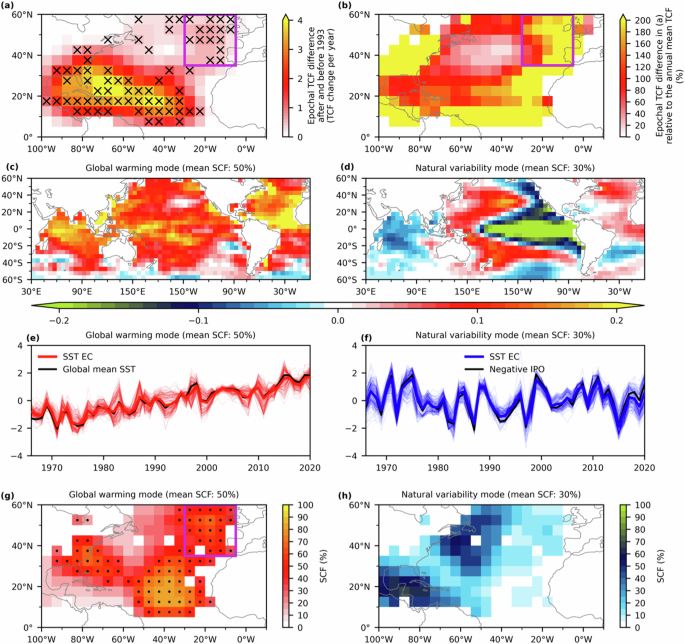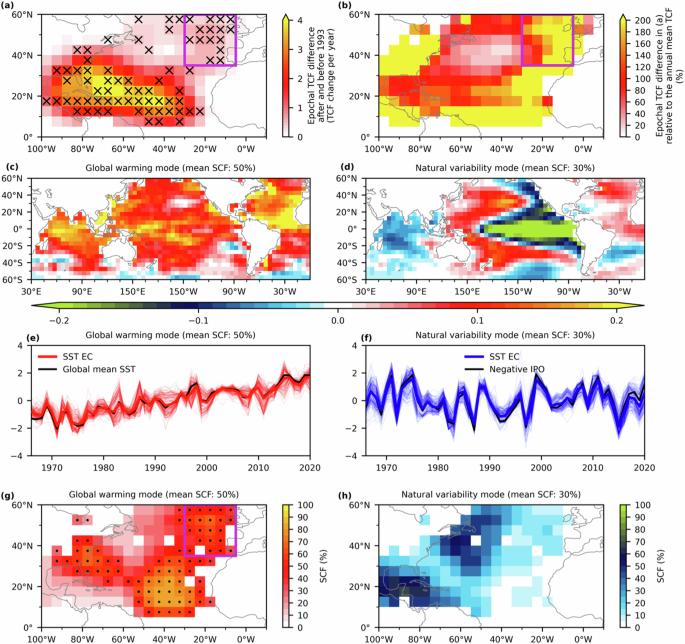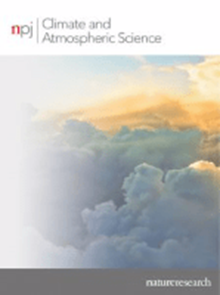人类活动对西欧附近热带气旋的影响
IF 8.5
1区 地球科学
Q1 METEOROLOGY & ATMOSPHERIC SCIENCES
引用次数: 0
摘要
由于可靠的观测记录持续时间相对较短,人们对人类活动是否显著改变了热带气旋(TC)的统计数据还没有达成共识。在某些热带气旋活动较少但暴露程度较高的沿海地区,如西欧,了解和预测热带气旋频率变化更具挑战性。在这里,我们通过大集合模拟表明,1966 年至 2020 年期间在西欧附近观测到的 TC 频率增加很可能与人为气溶胶效应有关。在气溶胶排放受区域控制、温室气体浓度大幅增加的未来情景下(共享社会经济路径 5-85),我们的模拟结果表明,到 21 世纪末,西欧附近的热带气旋频率可能会降低。历史和未来热带气旋频率的这些对比趋势主要是由于北大西洋热带气旋成因频率在 1966-2020 年间上升,以及随后在 2030-2100 年间可能下降。研究发现,大尺度环境条件对人为强迫的响应是解释西欧附近历来和未来热气旋频率变化的关键。本文章由计算机程序翻译,如有差异,请以英文原文为准。


Anthropogenic effects on tropical cyclones near Western Europe
There is less consensus on whether human activities have significantly altered tropical cyclone (TC) statistics, given the relatively short duration of reliable observed records. Understanding and projecting TC frequency change is more challenging in certain coastal regions with lower TC activity yet high exposure, such as Western Europe. Here, we show, with large-ensemble simulations, that the observed increase in TC frequency near Western Europe from 1966 to 2020 is likely linked to the anthropogenic aerosol effect. Under a future scenario featuring regionally controlled aerosol emissions and substantially increased greenhouse gas concentrations (Shared Socioeconomic Pathway 5-85), our simulations show a potential decrease in TC frequency near Western Europe by the end of the 21st century. These contrasting trends in historical and future TC frequencies are primarily due to the rise for 1966–2020 and potentially subsequent fall for 2030–2100 in TC genesis frequency in the North Atlantic. The response of large-scale environmental conditions to anthropogenic forcing is found to be crucial in explaining the historical and future changes in TC frequency near Western Europe.
求助全文
通过发布文献求助,成功后即可免费获取论文全文。
去求助
来源期刊

npj Climate and Atmospheric Science
Earth and Planetary Sciences-Atmospheric Science
CiteScore
8.80
自引率
3.30%
发文量
87
审稿时长
21 weeks
期刊介绍:
npj Climate and Atmospheric Science is an open-access journal encompassing the relevant physical, chemical, and biological aspects of atmospheric and climate science. The journal places particular emphasis on regional studies that unveil new insights into specific localities, including examinations of local atmospheric composition, such as aerosols.
The range of topics covered by the journal includes climate dynamics, climate variability, weather and climate prediction, climate change, ocean dynamics, weather extremes, air pollution, atmospheric chemistry (including aerosols), the hydrological cycle, and atmosphere–ocean and atmosphere–land interactions. The journal welcomes studies employing a diverse array of methods, including numerical and statistical modeling, the development and application of in situ observational techniques, remote sensing, and the development or evaluation of new reanalyses.
 求助内容:
求助内容: 应助结果提醒方式:
应助结果提醒方式:


